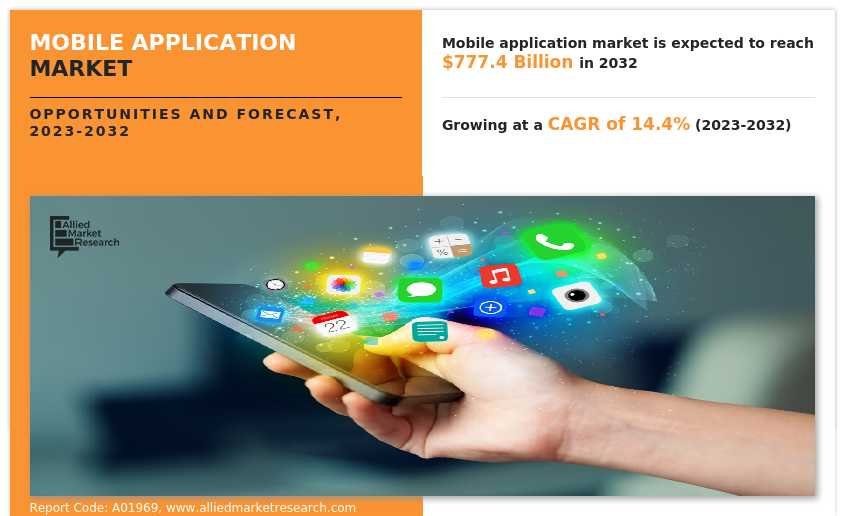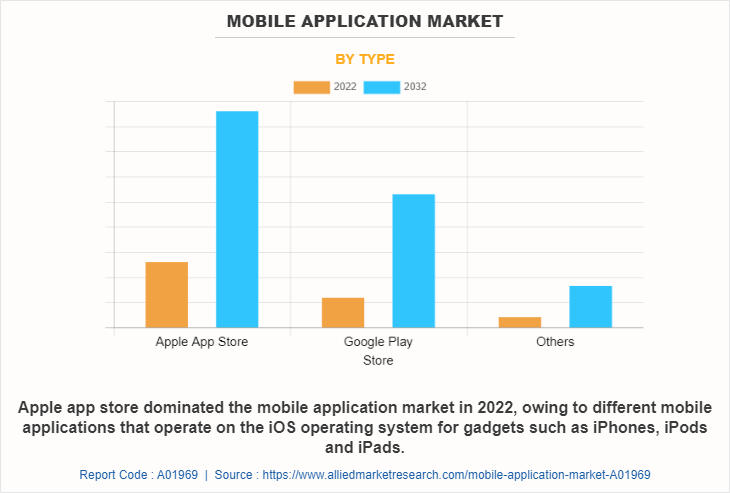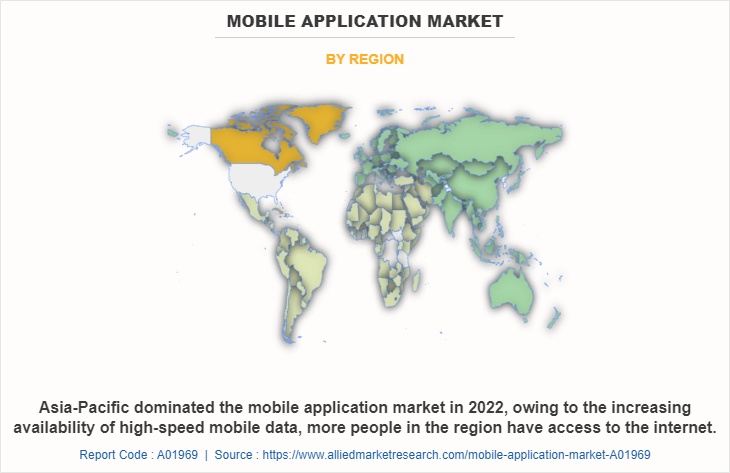Mobile Application Market Insights, 2032
The global mobile application market size was valued at USD 208.5 billion in 2022, and is projected to reach USD 777.4 billion by 2032, growing at a CAGR of 14.4% from 2023 to 2032.
A mobile application is a work of software that is intended to run on a mobile device. Mobile applications deliver similar performance as PC software. The apps, however, are tiny in comparison and occasionally only provide limited functionality, including games, calculators, or mobile web browsing. The popularity of these apps is attributed to their simplicity of usage. Some of the well-known marketplaces, including the Apple App Store, offer apps for smartphones and other mobile devices. Various online markets, include the Google Play Store, the Microsoft Windows Store, the BlackBerry OS App Store, and others.

Moreover, the integration of advanced technologies such as AI, ML and cloud computing has the potential to create several benefits for businesses and consumers, including detecting and responding to emerging threats more effectively. A mobile application service can help to improve efficiency and productivity for end users, as well as reduce costs. Moreover, it can provide enhanced security solutions and a better user experience for end users. In addition, mobile applications provide flexibility and scalability to adapt to evolving and changing consumer requirements. These aforementioned factors are anticipated to provide lucrative opportunities for mobile application market growth during the forecast period.
Furthermore, factors such as rise in variable device use and expanding client base in the e-commerce sector. Surge in enterprise applications, more attention on apps specifically utilized for health & fitness, strong download rates, and in-app purchases for gaming apps boost the mobile application market growth. However, the absence of high-speed connectivity in developing and underdeveloped areas as well as businesses' reluctance to develop their own applications are anticipated to restrain market expansion. In addition, rise in digitization investments, increased adoption of internet of things technologies, and mobile connectivity of smart items are anticipated to offer significant opportunities for mobile application market trends.
The mobile application market is segmented into type, application, and region. By type, it is classified into Apple app store, Google play store, and others. By application, the market is categorized into gaming, social media and entertainment, health and fitness, travel and hospitality, retail and e-commerce, learning and education, and others. Region wise, it is analyzed across North America, Europe, Asia-Pacific, and LAMEA.
The global mobile application industry is dominated by key players such as Microsoft Corporation, Hewlett Packard Enterprise Development LP, Apple Inc., Intellectsoft US, Cognizant, Google LLC, Verbat Technologies, International Business Machines Corporation, CA Technologies, Inc., and China Mobile Limited. These players have adopted various strategies to increase their market penetration and strengthen their position in the mobile application industry.

On the basis of the type, the global mobile application market share was dominated by the Apple app store segment in 2022 and is expected to maintain its dominance in the upcoming years, owing to different mobile applications that operate on the iOS operating system for gadgets such as iPhones, iPods and iPads. This store is a central location for iOS users to find, download, and update their favorite programs, boosting their overall mobile experience. However, the Google play store segment is expected to witness the highest growth, owing to provides developers with a platform to distribute their applications to android users globally.

By region, Asia-Pacific dominated the market size in 2022 for the mobile application market. The same region is expected to exhibit the highest growth during the forecast period, owing to vast and diverse population, leading to the creation of region-specific or culturally relevant apps. In addition, with the expansion of internet connectivity and the increasing availability of high-speed mobile data, more people in Asia have access to the internet.
Top Impacting Factors:
Increase in Data Usage & Internet Penetration
The increase in the number of mobile applications is closely related to the increase in data usage. Users are consuming more data due to high-speed internet connectivity and cost-effective data plans. Mobile applications are anticipated to gain popularity on account of the growing data usage. Users can now stream films, play online games, and use data-intensive programs without any issues on mobile devices. The demand for mobile applications that can effectively provide these services is fueled by the increase in reliance on data-driven activities. New markets and user bases are becoming available for mobile applications owing to growing internet penetration. There are many more potential users of mobile applications as more areas and groups have access to the internet.
This is especially clear in emerging economies where internet usage is growing quickly. Regardless of their location or access to traditional infrastructure, consumers can easily access a variety of services and information on their cell phones due to mobile applications. Mobile applications are an appealing choice for consumers in locations with limited access to other kinds of technology due to their accessibility and ease. In addition, the growth of creative mobile applications is fueled by the rise in data usage and internet adoption.
Surge in Adoption of Wearable Devices
Mobile applications are frequently used by wearable technology to improve functionality. Users can access and manage numerous functions and settings using the connections of devices to smartphones or tablets via specialized programs. For instance, smartwatches enable users to receive notifications, make calls, and interact with applications straight from their wrist, whilst fitness trackers sync with smartphone applications to deliver real-time health and fitness data. The expansion of the capabilities of wearable technology through interaction with mobile apps provides a seamless user experience.
Mobile application developers have new options due to the explosion in wearable device adoption. Developers are concentrating on making applications specifically for wearables due to the demand for these devices. Examples of applications that are only available for fitness trackers include those that monitor heart rate, track sleep patterns, and offer guided workouts. Developers can target a specialized market and respond to the unique demands and preferences of wearable device users by specializing in wearable applications. As more consumers use wearables devices, developers are looking at new ways to exploit the capabilities and sensors of these gadgets, to provide individualized and contextually aware experiences, applications are developed that make use of features such as GPS, accelerometers, heart rate monitors, and motion sensors. For instance, some apps use a smartwatch's GPS to send location-based reminders, while others use augmented reality glasses to superimpose digital data on the physical world. The development of cutting-edge apps is propelled by the convergence of wearable technology and mobile applications.
Key Benefits for Stakeholders
- This report provides a quantitative analysis of the market segments, current trends, estimations, and dynamics of the mobile application market analysis from 2022 to 2032 to identify the prevailing mobile application market opportunities.
- The mobile app market research is offered along with information related to key drivers, restraints, and opportunities.
- Porter's five forces analysis highlights the potency of buyers and suppliers to enable stakeholders make profit-oriented business decisions and strengthen their supplier-buyer network.
- In-depth analysis of the mobile application market forecast assists to determine the prevailing mobile application market opportunities.
- Major countries in each region are mapped according to their revenue contribution to the global mobile app market.
- Market player positioning facilitates benchmarking and provides a clear understanding of the present position of the market players.
- The report includes the analysis of the regional as well as global mobile application market trends, key players, market segments, application areas, and mobile application market growth strategies.
Mobile Application Market Report Highlights
| Aspects | Details |
| Market Size By 2032 | USD 777.4 billion |
| Growth Rate | CAGR of 14.4% |
| Forecast period | 2022 - 2032 |
| Report Pages | 277 |
| By Type |
|
| By Application |
|
| By Region |
|
| Key Market Players | Microsoft Corporation, Hewlett Packard Enterprise Development LP, Verbat Technologies, Apple Inc., International Business Machines Corporation, CA Technologies, Inc., Google LLC, Intellectsoft US, China Mobile Limited, Cognizant |
Analyst Review
The mobile applications market is expanding quickly and has integrated itself into the digital environment. Mobile applications provide customers with a wide variety of features and services owing to the growing popularity of smartphones and tablets, . The demand for personalized and practical user experiences is driving the market growth for mobile applications. Users are actively looking for applications that meet their unique requirements and interests whether it is for social networking, gaming, productivity, shopping, or any other purpose. Therfore, developers are producing a wide range of applications to satisfy various preferences and requirements of smartphone users. The potential user base for mobile applications has grown with the increase in smartphone owners.
Smartphones are entering previously untouched sectors, such as developing nations and rural areas, as they become affordable. Developers now have more opportunities to connect with a wider audience and meet the unique requirements and preferences of these individuals. However, there are difficulties and ambiguities that limit the development of mobile applications. The seamless use, access to features, and availability of some types of applications are hampered by the lack of high-speed connectivity in emerging and undeveloped locations. In addition, businesses must deal with risks related to the fast changing technological landscape, ROI, market demand, and the technical resources and experience required to develop mobile applications. Developers are focusing on development and introduction of new applications to match user requirements and industry trends in this highly competitive and dynamic sector. Smartphone accessibility and worldwide reach give developers the chance to target a large and varied customer base.
The global mobile application market size was valued at USD 208.5 billion in 2022, and is projected to reach USD 777.4 billion by 2032
The global mobile application market is projected to grow at a compound annual growth rate of 14.4% from 2023-2032 to reach USD 777.4 billion by 2032
The global mobile application industry is dominated by key players such as Microsoft Corporation, Hewlett Packard Enterprise Development LP, Apple Inc., Intellectsoft US, Cognizant, Google LLC, Verbat Technologies, International Business Machines Corporation, CA Technologies, Inc., and China Mobile Limited. These players have adopted various strategies to increase their market penetration and strengthen their position in the mobile application industry.
Asia-Pacific is the largest regional market for Mobile Application
Factors such as rise in variable device use and expanding client base in the e-commerce sector. Surge in enterprise applications, more attention on apps specifically utilized for health & fitness, strong download rates, and in-app purchases for gaming apps boost the mobile application market growth.
Loading Table Of Content...
Loading Research Methodology...



